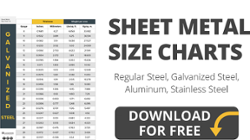 How well do you know your sheet metal cutting and shearing terminology? Pretty well? Or could you use a refresher so you can understand what your sheet metal fabricator is trying to do and how to effectively communicate with it?
How well do you know your sheet metal cutting and shearing terminology? Pretty well? Or could you use a refresher so you can understand what your sheet metal fabricator is trying to do and how to effectively communicate with it?
We’ve put together this handy sheet metal glossary just for you. It’s a nice resource for all the important sheet metal terms that you should know. In addition to the benefits listed above, knowing your terms can help you make better decisions on sheet metal cutting practices.
With different types of cutting processes, your trusted sheet metal fabricator can create specific types of cuts. Some can have an open path or a closed path.
Here's more on the popular sheet metal cutting processes:
Your Sheet Metal Glossary of Terms
In alphabetical order, here are the most important terms to be familiar with in sheet metal cutting:
-
Accuracy: The difference between the actual measurement and the measurement from the machining system. If the difference is less, then you have a very accurate process. Accuracy also refers to how precisely you can shear or laser cut sheet metal.
-
Blanking: A cutting procedure that removes a piece of sheet metal from a larger stock piece by administering shearing force. Unlike punching, pieces removed – or “blanks” – are not scrap, as what’s created is the actual intended part. Blanking is used for cutout parts. These are used when a project might require a 2D shape. It's common to use blanking for simple geometries.
-
Cell manufacturing: The setting up of long-term work stations with high repeatability, using VAVE concepts. It’s all about finding the most efficient way of organizing the shop floor to ensure increased quality and production. Most importantly, cell manufacturing helps companies retain market share and sustain profitability
-
Design for manufacturability (DFM): The general engineering practice of designing products in such a way that they are easy to manufacture correctly.
-
Etching: Marking metal without cutting all the way through it. Typically performed by reducing the power of the cutting tool being used.
- Fine blanking: A special type of blanking technique. The blank will be sheared from a piece of stock. The technique requires 3 different forces.
-
Gauge (thickness): A measurement that refers to the thickness of the sheet metal. Thicker workpieces are harder to manipulate.
-
Heat distortion: When the welder doesn’t distribute heat evenly in a weld, causing stress and perhaps cracking on the workpiece.
-
Kerf: Any cut (i.e., groove, slit, notch, etc.) that’s made using a cutting tool, like a laser cutter.
- Lancing: A way to make partial cuts into a piece of stock. When this is performed, none of the material will be removed. The material is intact and can be bent and formed into a particular shape. It's commonly used to make tabs or vents.
-
Laser cutting: The practice of using a high-powered laser to slice through sheet metal. Laser cutting works by using the energy of the beam to melt the metal that it is working with.
-
Melting point: The melting temperature of the material. Materials with high melting points require more energy to cut.
-
MIG welding: Metal inert gas welding. An arc welding process in which a continuous solid wire electrode is fed through a welding gun and into the weld pool, joining two materials.
-
Multiple punching: See “Perforating.”
- Nibbling: Uses a series of small punches that overlap holes or slits. This is done in a particular path to cut out a section for a bigger shape that's contoured. When nibbling is used, custom pinching and dies are not required. A secondary operation to the material can help ensure accuracy and the finish.
- Notching: A way to punch the edge of the sheet. When this is done, it creates notches in a particular shape.
- Parting: A way to separate a section of the sheets. The section of material between the sheets is punched away.
-
Perforating: Also known as “multiple punching,” this is where metal is punched in a pattern to create identical holes, often in a single line.
- Piercing: A way to create a hole in a sheet with punches. The result is a hole that's created by a cylindrical punch.
-
Plasma arc welding: The joining of metals through heating the workpiece with a constricted arc. Creates a higher heat content than other welding methods.
-
Porosity: Gas bubbles that occur when shielding gas becomes trapped with a weld and leaves tiny holes. This cause cracks and weakened weld joints.
-
Prototype: A test part that’s used to analyze form, fit, and function prior to manufacturing.
-
Punching: Cutting using shearing force. Often used to create holes of varying size and shape, the material that is “punched” is discarded as scrap, making the process different from blanking.
-
Repeatability: Also often referred to as “precision,” this describes the ability of a cutting machine to perform the cutting pattern or position again. Typically measured in ten-thousandths of an inch, the smaller the repeatability tolerance, the more similar or accurate the cuts.
-
Seam weld: A variation of resistance spot welding. In seam welding, however, the welding electrodes are motor-driven wheels as opposed to stationary rods. Used to join two sheets of metal together.
-
Shearing: A cutting process that uses force perpendicular to the material surface, forcing the material to its yield point and resulting in breakage. The edges are also sheared in the process. This technique is used to cut metal into smaller parts, which can then be used in other processes.
- Slitting: The cutting of straight lines into the metal. This doesn't create separations, and there is no scrap produced.
- Slotting: A punching technique similar to piercing. It creates rectangular boxes in a sheet.
-
Spot weld: A process in which contacting metal points are fused by the heat created from resistance to electric current.
-
Stress cracking: A fracture or crack that occurs after a part or material reaches its maximum yield point.
-
Tensile strength: The maximum amount of weight (or load) that a material can withstand at its cross-section.
-
TIG welding: Tungsten inert gas welding. Uses a non-consumable tungsten electrode that delivers the current to the welding arc. Uses a long welding rod rather than the feeding wire you see in MIG welding.
-
Tolerances: Variation from a material’s original specs. Tolerance can either be allowable or predictive.
-
VAVE: Value Analysis/Value Engineering. When a fabricator analyzes and improves value in a product, reducing costs and other inefficiencies.
-
Value engineering: A systematic method to improve the "value" of products by looking for cost inefficiencies in the manufacturing process, start to finish.
-
Yield point: The point at which a material breaks, thereby deterring from its stress-to-strain ratio.
Need to Know More?
How well do you know your sheet metal terminology? Are you an expert or are you still learning the terms your vendor uses?
While it can be argued that all of us are still learning, regardless of our industry experience, it never hurts to revisit some of the key terms in cutting and shearing. And if you have any other questions about the sheet metal fabrication process, always ask a vendor before you send out a design.
(Editor's Note: This article was originally published in November 2018 and was recently updated.)


